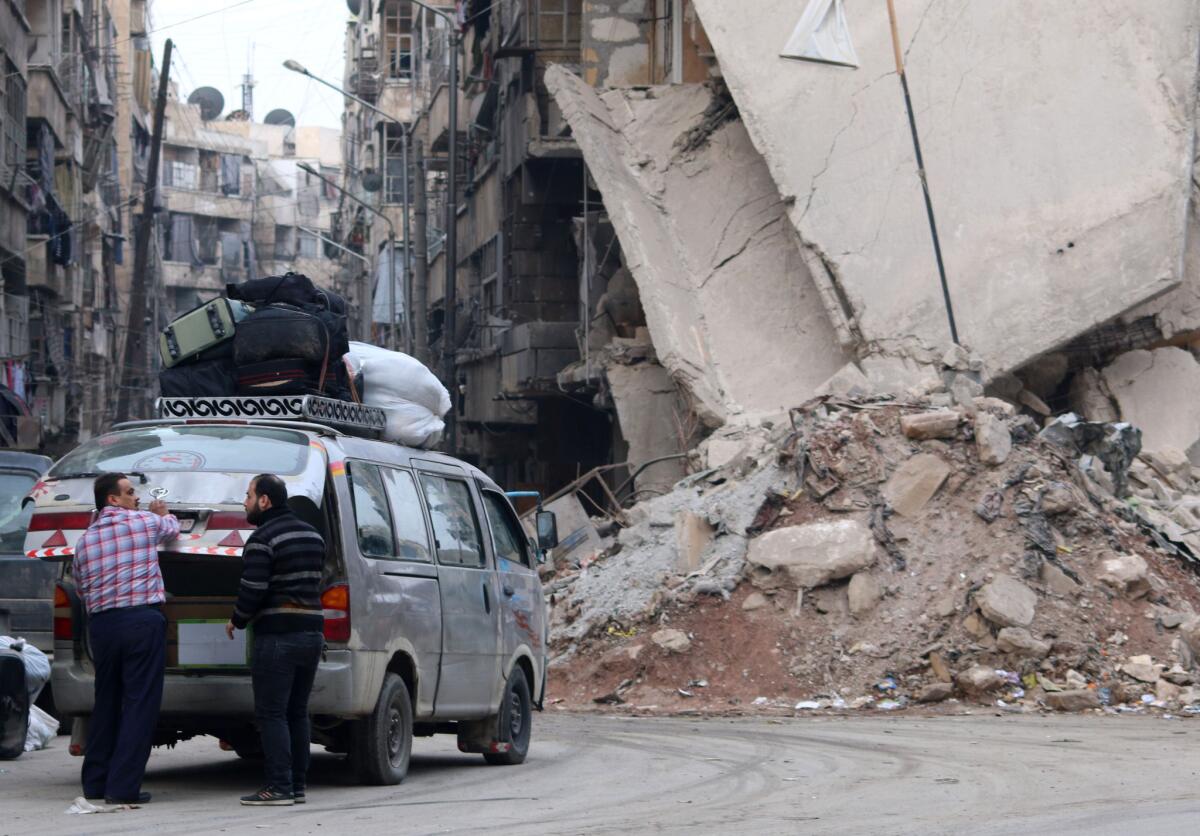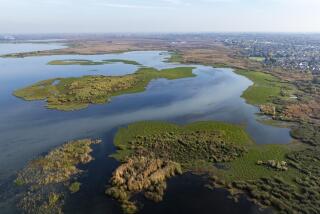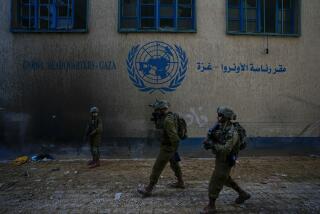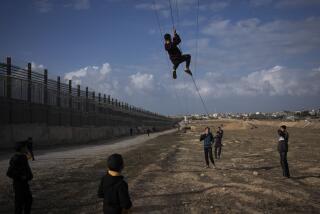Syrian rebels, increasingly desperate, turn to tunnel warfare

Reporting from Aleppo, Syria — For three days, Syrian rebels dug through a wall of a library that housed a trove of historical religious texts, and underneath an adjacent road.
When they were done with the 50-foot-long tunnel, they waited at one end of it for a tank to drive by, and blew it up.
The explosion cut off the road, a crucial supply route for government soldiers stationed at the nearby 13th century citadel, but it also destroyed what was left of the Waqifiyya Library, already damaged during months of clashes.
Rebel commander Iyad Saqaan, who in 2006 had helped furnish the library with woodwork from his studio, had also overseen the digging of the tunnel. Sitting on a mound of rubble, skipping rocks as if perched on the edge of a lake, Saqaan pursed his lips, shook his head and said, “What alternative do we have?”
As the increasingly destructive Syrian conflict drags on, outgunned rebel groups have become dependent on guerrilla-style tactics better suited to a lopsided battle.
Government forces are now on the verge of laying siege to parts of Aleppo long held by opposition groups that began the rebellion against President Bashar Assad in 2011. An estimated half a million residents could be cut off from food, medicine and fuel in a city that was once Syria’s commercial hub.
The rebels, who have also lost ground in northern Syria to the militant group Islamic State, acknowledge that they don’t have the weapons to stave off a government advance here. Losing Aleppo would be a major setback for the rebels, both symbolically and military, as it is the last provincial capital where they still hold significant ground.
With limited ability to succeed on the front lines, the rebels have taken to digging tunnels under bases, buildings and roads and setting off explosives, trying to kill a few dozen soldiers at a time. They have also launched homemade rockets, often inaccurate, at government forces stationed in landmark structures, frequently killing civilians. In the process, they are helping destroy Syria’s history and infrastructure and, with the deaths of civilians, undermining popular support for their cause.
“It has become an underground war,” said Capt. Abu Baraa, a commander with the Islamic Front, a coalition of Islamist rebel brigades, who defected from the Syrian army.
Casualties have included many of the country’s most treasured sites, which date back centuries. In Aleppo alone, 121 historical buildings have been damaged or destroyed, according to the United Nations Educational, Scientific and Cultural Organization.
A recent analysis of satellite imagery showed that five of the six UNESCO World Heritage sites in Syria have incurred significant damage.
The agency says the tunnel explosions placed the citadel and surrounding buildings at high risk of destruction. Rebels contend they have had little choice but to attack historic buildings because that’s where the government forces are.
“We are open to all possibilities — tunnels, car bombs,” said Abdulkareem “Abu Firas” Laila, a spokesman for the Islamic Front. “Everything is a possibility in order for the revolution to continue.”
The tunnel strategy was first seen around Damascus, the capital, and the central city of Homs. But in the last year or so, rebels in the north, using tunnels, have blown up the Carlton Citadel hotel, a 150-year-old landmark; the Justice Palace, an old municipal courthouse; an unused orphanage; Aleppo’s police headquarters; and a portion of the Wadi Deif military base in neighboring Idlib province.
::
Aadil “Abu Assad” Nasir, who worked in construction before the uprising, has been the man behind the tunnels. He got the idea during the summer of 2013 from a Palestinian journalist who was covering rebel operations.
“He said, ‘Abu Assad, why haven’t you used tunnels?’ I said, ‘What are these tunnels?’ He said, ‘We weren’t victorious except with the use of tunnels,’” the journalist said, referring to a strategy the Hamas militant group has used in the Gaza Strip.
“He said, ‘You’ll succeed with the tunnels,’” Nasir recalled.
Nasir began speaking with experts in Syrian topography to learn which tools were needed to break through the rocky earth and with engineers to learn about tunnel stability.
Back then, the rebels were in a better situation militarily but lacked the advanced weapons needed to defeat government forces. Some $500 million approved by U.S. lawmakers to train and arm Syrian rebels is aimed not at defeating Assad but at battling Islamic State. Lacking sufficient international funding for weapons and having suffered numerous battlefield defeats, rebels in the Aleppo area have grown increasingly worried. As their fortunes waned, the tunnel attacks grew larger.
The first explosion in Aleppo was a small one, in a historic market near the 12th century Umayyad Mosque.
One of the largest was in March at the Justice Palace; dozens of government soldiers are believed to have been killed. What remains of the historic courthouse — where lawyers staged peaceful protests for more than a year after the uprising began in 2011 — is mostly blackened with soot, the floors covered with papers from decades of legal proceedings. For about two years, government snipers had used the four-story building as a deadly vantage point.
“We tried storming it many times and we lost many men trying to take it. We decided this was the only way,” Abu Baraa said. “All our means are basic. If we had better weapons, we wouldn’t have to dig and we wouldn’t have to blow anything up.”
Digging the 130-foot-long tunnel took three months, and the explosion forced government troops to withdraw to the other side of a public park.
“It’s a good tactic and we are able to advance, but it’s building by building,” Abu Baraa said.
When Assad’s soldiers stormed through towns and villages in the early days of fighting, they left behind threatening graffiti: “Assad or we burn the country.” And though the rebels say they are torn over their role in Syria’s gradual demolition, their desperation has pushed them toward extreme strategies.
“So are we going to engage in guerrilla warfare?” asked Ossaid Basha, a spokesman with Islamic Front’s media arm.
“That has already started,” said Islamic Front commander Samir Zeitoun.
::
Even though the government has superiority on the ground and in the air, its forces have also taken to digging tunnels, to counter the rebel strategy.
After the Justice Palace bombing, rebels discovered a nearly completed tunnel running parallel to the one they had just detonated. Had they waited a few days, the commander said, their own position would have been attacked.
On a quiet Friday, the ground shook slightly in Aleppo’s Old City. Rebels turned to Nasir and asked, “Is there an operation planned?”
He shook his head.
Soon news arrived that government troops at the citadel had dug a tunnel near a rebel outpost and blown it up. Saqaan, the woodworker-turned-commander, who had been making the rounds at front-line positions, was struck in the head by a rock and killed.
As his shroud-wrapped body lay in the cobblestone street, fighters debated where to bury him.
The cemetery had no more room, so they had to reuse the grave of his mother, who had died 16 years earlier. They pushed the dry bones to one side to make room for another body.
As in the digging of the tunnels that Saqaan had overseen, workers used pickaxes to break through the concrete top of the underground vault.
It was a quick job. It took less than an hour to break a hole, one just big enough for the body of a rebel commander.
More to Read
Sign up for Essential California
The most important California stories and recommendations in your inbox every morning.
You may occasionally receive promotional content from the Los Angeles Times.











